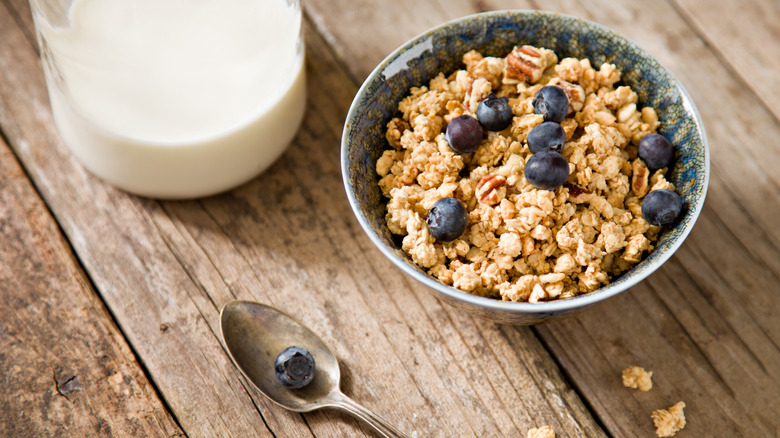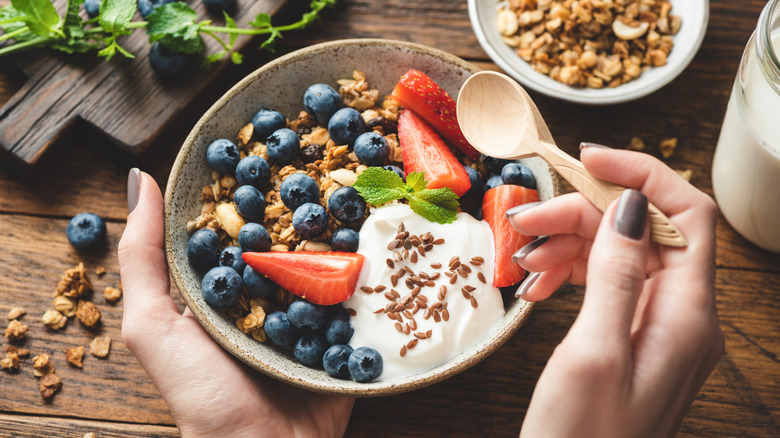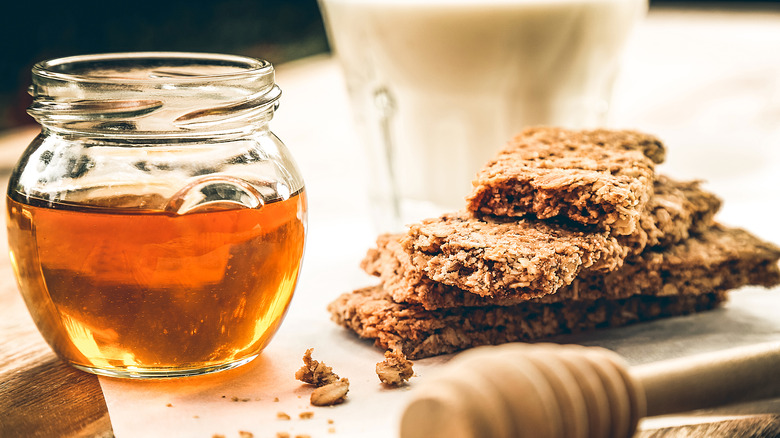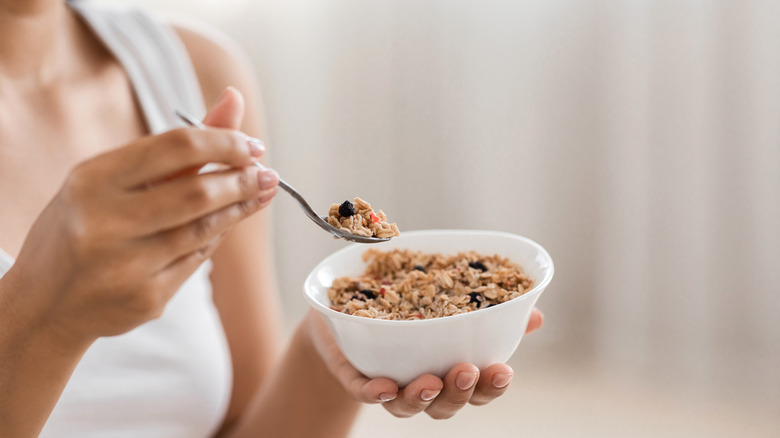What Happens To Your Body When You Eat Granola Every Day
If you were to ask a group of people if they've heard of granola, chances are they'll unanimously say they have. But if you followed up by asking what's in granola, you'll probably get more than one answer. As registered dietitian Cynthia Sass told Time, "There is no one standard formula for granola ... ." Although the Merriam-Webster dictionary says that it usually contains oats, there are also grain-free versions of granola. And the fact that granola recipes can vary has raised questions about whether or not it's good for one's health.
Although members of the counterculture of the 1960s embraced granola as a way to differentiate themselves from the previous generation, its mainstream popularity happened in the 1970s (via Los Angeles Times). But as more companies jumped on the granola bandwagon in the 1980s, they also began experimenting and adding new ingredients like chocolate and peanut butter. However, this strategy backfired with the public viewing granola as less healthy.
So, is today's granola just another sweet-but-not-very-healthy treat? Well, the main thing to remember is granola ingredients can vary, so it's very important to check a particular brand's Nutrition Facts label. This and proper portion control can make all the difference when it comes to how granola might affect one's health. And, of course, you should always check with a healthcare professional before adding something (or more of something) to your diet. However, traditional, oat-based granola can provide several benefits if you eat it every day.
It might raise or lower your bad cholesterol
It can be confusing and frustrating when a food might either have a positive or negative effect on one's health. For instance, granola might be a good or a bad choice for managing cholesterol. It's all a matter of what ingredients are used in a particular granola recipe.
Before we go any further, however, let's clear up some frequent misconceptions about cholesterol. As MedlinePlus explains, cholesterol isn't automatically something negative unless there's too much of it. When the body has a high amount of low-density lipoproteins (which are made up of fat and protein), cholesterol can accumulate in one's arteries. In fact, low-density lipoproteins are also referred to as LDL and "bad" cholesterol.
However, WebMD notes that beta-glucan might help lower LDL levels. And, since oats are a good source of beta-glucan, eating foods made with them (like granola) might help with "bad" cholesterol.
Despite granola being a source of beta-glucan, WebMD cautions that granola can be loaded with saturated fat, which can increase one's LDL levels. The site also warns that products claiming to be low fat or low in cholesterol could still contain significant amounts of saturated fat. So, it's important to research different brands of granola and choose one that's low in saturated fat, uses ingredients like dried fruit instead of less healthy sweeteners, and has good fiber content.
It might help support your brain's health
As WebMD notes, there are many ingredients commonly used to make granola. Among them are nuts, including walnuts. But, even if walnuts aren't your favorite thing to eat, you might want to consider adding them to your granola because of their potential impact on your brain.
To fully understand why walnuts might be "brain food," we need to discuss oxidative stress, which as Medical News Today explains, has to do with our body's cells. Remember, our cells naturally have metabolic processes during which they create damaging molecules called "free radicals," as well as substances that counteract these molecules called "antioxidants." When the balance between the two is off, oxidative stress can occur. And, according to the American Society for Nutrition, cognitive decline due to age and oxidative stress can go hand in hand. Walnuts, however, contain a type of omega-3 fatty acid, and as Nao Medical states, omega-3 fatty acids have "powerful antioxidant properties." Additionally, walnuts have compounds called "polyphenols" that can work as antioxidants in the body (via Colorado State University).
Although the walnuts found in some granola recipes might help with age-related cognitive decline, it's important to keep in mind that granola can be high in sugar. And having too much sugar in one's diet can increase the chances of experiencing oxidative stress on a long-term basis (per American Society for Nutrition). So, make sure to check the Nutrition Facts label on store-bought granola.
You might feel fuller longer
While granola recipes can vary, a number of them contain a good amount of fiber and protein (per Consumer Reports). As Dr. Lauri Wright, chair of the Department of Nutrition and Dietetics at the University of North Florida in Jacksonville, told Consumer Reports, " ... that combination can help you keep you fuller longer." But before rushing out to buy granola to help with weight management, there are some things to keep in mind.
First, however, let's talk about protein and fiber, which as Dr. Wright explained to Consumer Reports, come from common granola ingredients like seeds, nuts, and whole grains. According to Harvard Health Publishing, fiber immediately gives one the sensation of feeling full while protein helps you stay full for longer. But even though fiber and protein can be helpful, Consumer Reports nutritionist Ellen Klosz noted that protein is usually already in people's diets from other sources besides granola. Fiber, however, can be another story, so Consumer Reports advises looking for a granola that has at least 3 grams of fiber per serving, and Klosz recommends opting for fiber that comes from whole foods rather than processed ingredients.
Although the Mayo Clinic notes that foods like granola bars might help with weight management because of their high fiber content, it's important to also take into consideration other factors like calories and sugar content. Portion control is also crucial. So, if you're looking to better manage your weight, work with a healthcare professional.
You'll be consuming more carbs
It's probably not a shock that granola contains carbohydrates, but there's more to carbs than many people realize. As NBC explains, they, along with fat and protein, are macronutrients. When our bodies process carbs, they become glucose (also known as blood sugar), and glucose is an energy source for our cells.
As registered dietitian Nancy Clark told Time, "For active people, granola is best known for being a source of carbohydrates to fuel the muscles and provide energy for a busy day." In particular, Clark focused on grains "to fuel muscles" (Remember: Oats and other cereals can be a major ingredient in a granola recipe). However, registered dietician Cynthia Sass also noted that other ingredients used in different types of granola can add sugar to the mix. These can include foods like honey and maple syrup. And as NBC pointed out, " ... anything that has sugar has carbs."
Now, in case you're thinking "Does it really matter where carb content comes from in my granola," keep in mind that there are both simple and complex carbs (per NBC). So, while the whole grains used in various granola recipes would fall under the category of complex carbs, honey, and maple syrup are simple carbs. And, as you've probably experienced, eating simple carbs can give you a burst of energy (or what's known as a "sugar rush"). On the other hand, whole grains are packed with things like vitamins, minerals, and fiber.
It could impact your blood sugar levels
Granola has the potential to either help lower blood sugar levels that are too high or make them even higher. As WebMD explains, two common granola ingredients — dried fruits and whole grains — are sources of fiber, which can help keep blood sugar levels steady instead of spiking. In fact, Beyond Type 2 notes that traditional granola is in part made from oats, and oats contain soluble fiber.
However, Beyond Type 2 cautions that multiple cereals can be part of a granola recipe, which automatically means granola contains carbs. Such cereals can include not only oats but also corn, wheat, and amaranth. In addition, the dried fruit used in some granolas can also up its sugar content. And then there are other sweet ingredients found in different granola recipes like maple syrup and honey both of which can not only raise one's blood sugar levels but also raise them quickly.
Of course, there are granolas marketed as sugar-free, but as Beyond Type 2 explains, if a granola contains cereals and/or dried fruit, it still has carbs. The bottom line is while the fiber in granola might help keep blood sugar levels from spiking, other ingredients found in various granola recipes could have the opposite effect. And one more note: Combining granola with even healthy foods like yogurt or fruit can also add significant amounts of sugar. So, make sure to take all the ingredients into consideration and exercise proper portion control.
You'll be taking in more minerals
If you look at the ingredients in a multivitamin, chances are you'll find (despite its name) that it contains both vitamins and minerals. The major difference between the two is minerals are inorganic (they don't come from plants or animals) while vitamins are organic (per Harvard T.H. Chan School of Public Health). Regardless, both are important for one's overall good health and eating granola is a way to take in more important nutrients.
To demonstrate, let's look at a homemade recipe for granola that contains almonds, coconut, canola oil, honey, raisins, sunflower seeds, wheat germ, and, of course, oats (via U.S. Department of Agriculture (USDA)). If you were to eat 100 grams of this granola, you'd be taking in 539 milligrams of potassium. According to Better Health Channel, your body needs potassium for your muscles and your heart, as well as your nerves, to function. Additionally, 100 grams of this granola recipe is packed with 431 milligrams of phosphorus. And, as MedlinePlus explains, one of the ways your body uses phosphorus is to help repair your cells when they become damaged.
Furthermore, the USDA notes that the same 100 grams of the above granola recipe has 168 milligrams of magnesium and 76 milligrams of calcium. Both magnesium and calcium are important for your bones, according to Better Health Channel. In addition, your lungs and immune system both need magnesium; and, without calcium, your body would struggle to do basic functions like relaying messages through the nervous system.
It might help with high blood pressure
To be clear, granola isn't a cure for high blood pressure (via Nao Medical). And, if you have this condition, it's important to work with a medical professional to properly manage it. With that said, a healthy diet that could include granola can be a component of this management.
Remember, as the heart pumps, it circulates blood through the arteries and veins, but as Nao Medical explains, sometimes the blood pushes against the walls of the arteries with an abnormally high amount of force. This is what's known as "hypertension" or "high blood pressure." However, granola brings three important components to the table that can be beneficial for this condition. First, it contains fiber, which can help with high blood pressure because it can help with digestion and cholesterol. Granola recipes that include nuts or seeds have heart-healthy fats that can also be good for cholesterol management and, in the process, hypertension. Additionally, granola has antioxidants that can help keep blood vessels healthy and free of damage.
Furthermore, another reason to consider adding granola to a high blood pressure management diet is the sodium content of granola tends to be low (according to Nao Medical). Now, of course, if you make your own granola, you can pick whichever ingredients you want, making sure that it fits your health needs. But that doesn't mean store-bought granola is out as long as you're a conscientious consumer and read the Nutrition Facts label.
It might affect your bowel movements
Should you eat granola if you're constipated? The short answer is it depends on the granola. According to the Cleveland Clinic, constipation involves both problems passing stool (which can be hard and dry) and bowel movements occurring less often. And, as Nao Medical points out, ingredients found in different granola recipes can either help with constipation or even cause it.
For example, a basic ingredient of traditional granola is oats, which are packed with a material that can help keep one's bowel moving properly — fiber (via Nao Medical). Dried fruit is also used in granola recipes and has been shown to be beneficial for constipation patients. In addition, nuts and seeds — both of which are common components of granola — might also help with constipation. However, granola (and in particular granola bars) can also contain sugar, which could make a case of constipation more severe. In fact, Nao Medical cautions that consuming excessive amounts of granola bars could even be the cause of constipation. Finally, the preservatives, artificial colors, and other additives that can be found in different brands of granola could all exacerbate constipation.
Of course, if you make your own granola, you can control the ingredients; but, if you're thinking that homemade granola is a guaranteed cure for constipation, think again. Nao Medical cautions that being constipated "for more than a few days" is a red flag and that you should seek medical attention. So too are issues like nausea and pain.









